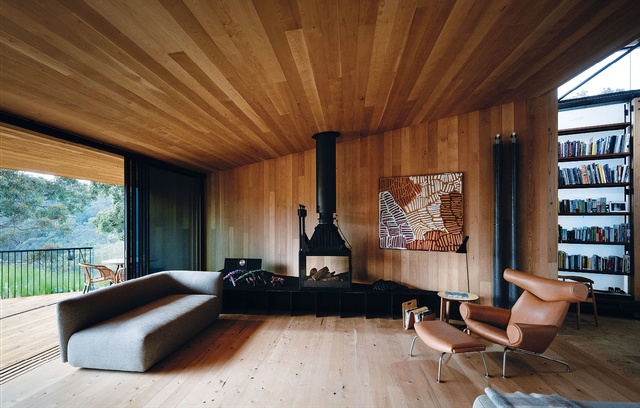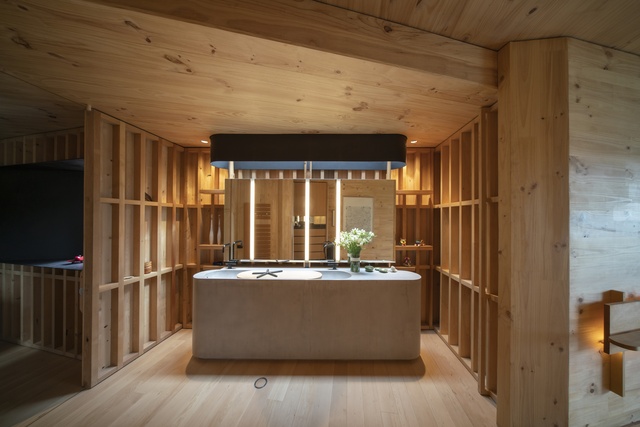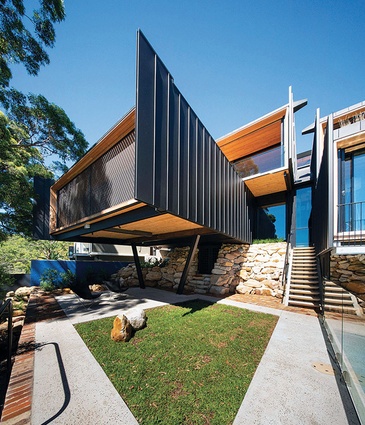Witty woodwork: Seed House
Adding to the architectural legacy of a salubrious Sydney suburb, this home for the architect’s own family is a volumetric study that celebrates the inherent qualities of timber.
There is something exciting about architects designing their own houses and unsettling the established triumvirate of visionary client, inspired architect and accomplished builder. And where better to practise this rare form of architecture than Castlecrag, on the lower North Shore of Sydney.
Once home to Walter Burley and Marion Mahony Griffin, who designed their own house there after planning the entire suburb, Castlecrag and its environs has hosted a rollcall of adventurous house-building architects – there are houses designed by Hugh Buhrich, Paul Frischknecht, Donald Maclurcan, and Bill and Ruth Lucas, to name a few, and a Gordon M. Jenkins house that is undergoing a renovation by Peter Tonkin and Ellen Woolley.

The Seed House, fashioned by James Fitzpatrick for his family, is the latest addition to the Castlecrag architectural legacy. The house has evolved over the eight years that the Fitzpatrick clan has inhabited the site, so that it is at once a volumetric masterpiece and the family’s perfect fit. Design was followed by two-and-a-half years of meticulous construction.
The project evokes beauty, warmth and richness through the crafting of timber. It takes its place alongside a number of recent technically advanced buildings to make use of CLT (cross-laminated timber), demonstrating the material’s potential for Australian residential architecture.
CLT has been used for the structure of a series of interconnected, cantilevered forms that make up the house. Inside the timber structural shells, there is an exotic array of Tasmanian timbers – celerytop pine, Huon pine and blackwood – sourced and collected over more than a decade, each marking out different areas and uses. James’s Tasmanian roots are reflected in the selection of timbers and in his skill in detailing.

These timbers already have rich associations for the Fitzpatricks and are imbued with stories of searching for and finding them, as part of the long- term plan for the house. Defining the bedrooms on the second storey, the celerytop pine was an unintended byproduct of the Tasmanian hydro-electricity scheme. Whole trees found in lake beds that had been flooded decades ago were extracted and left to dry out for two years.
The rarer blackwood in the kitchen joinery was similarly found in trees languishing in the flooded lake. Their sale was conditional upon the vendor’s approval that the precious timber was being used in large pieces for prominent and valuable elements, and not milled down into strips. The Huon pine, used mainly as joinery trim, was collected over multiple family visits to Tasmania, the shape of each piece influencing the shape of the finished joinery element.
Neatly fitting under the council recession plane, the house’s interconnected forms were conceived of as seed pods cascading down the hill. Each of these trumpet-shaped forms houses a different social function: there’s the kitchen, dining area, living space and the bedrooms. They stretch the house out into the landscape, their joints open to capture vistas of the distant geogra-phical features of Middle Harbour and Sugarloaf Hill. Between the two main halves of this composition, a slot for a stairway gives access down the contour of the hill and also draws views of rocky outcrops and angophora trees through the centre of the plan.

At the heart of the house lies the naturally lit entry hall, with kitchen and stairs at the periphery, and dining and circulation at the centre. The living spaces on the upper level are visually interconnected, while subtle level changes form sills from one space to the next.
The central stairway leads from the living room down to the bedrooms, and continues on to the pool terrace. The more enclosed bedrooms and bathrooms are defined by celerytop pine partitions; functional layers such as waterproof lining and shelves are added to these elements in contrasting materials. The spatial configuration of the bedroom level can be modified by reorienting a series of pivoting partitions. The house is further enriched by the many paths through it: a spiral stair at the hill end of the site drills into the ground, and a landscaped stair at the other end faces the view and follows the contour of the hill. A glass lift is another option.
The house’s rich timber detailing is wrapped in vertically seamed blackened-aluminium sheet cladding. Black steel window shrouds with deep reveals – along with an abundance of witty modernist details – are balanced by aged vernacular detailing such as the stretched mortar joints, which mirror those seen in the Griffins’ sandstone houses.

There is a clear spirit of architectural experimentation in the design of this house – and perhaps here is the crux of how the architect’s own house differs from the house of a client. We can also see the architect’s wit, where Le Corbusier’s conical concrete overflows have been reinterpreted in metal, where Hans Scharoun’s curved balustrade frames have been tweaked to accord with the Australian building codes, and where commercial flush glazing systems have been rescaled, reassigned, and given attitude and grace. All these gestures take their place in an architecture that is clearly residential.
This free flow of architectural inventiveness, and the proposition of timber as a timeless and sustainable construction material, make this house a worthy addition to the Castlecrag architectural legacy.
This article first appeared on architectureau.com.













